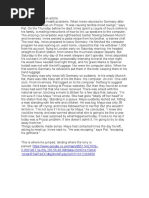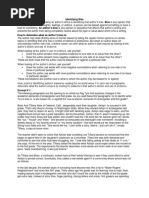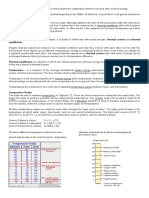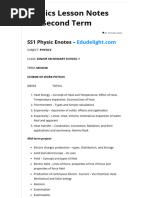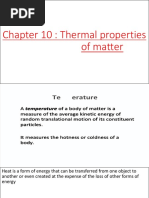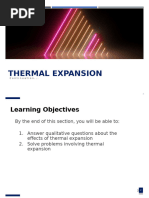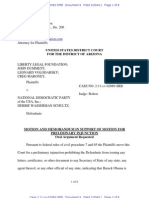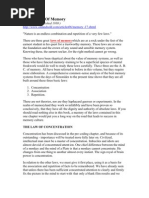Heat Lecture 1 Handouts Kunal
Heat Lecture 1 Handouts Kunal
Uploaded by
Vikram KumarCopyright:
Available Formats
Heat Lecture 1 Handouts Kunal
Heat Lecture 1 Handouts Kunal
Uploaded by
Vikram KumarOriginal Description:
Copyright
Available Formats
Share this document
Did you find this document useful?
Is this content inappropriate?
Copyright:
Available Formats
Heat Lecture 1 Handouts Kunal
Heat Lecture 1 Handouts Kunal
Uploaded by
Vikram KumarCopyright:
Available Formats
SCIENCE TECH SESSIONS FOR UPSC BY Er.
KUNAL SINGH
HEAT LECTURE 1 HANDOUTS
Temperature is defined as the degree of hotness or coldness of a body. The natural flow of heat is from higher
temperature to lower temperature.Two bodies are said to be in thermal equilibrium with each other, when no heat
flows from one body to the other. That is when both the bodies are at the same temperature.
(1) Temperature is one of the seven fundamental quantities with dimension [ ]. It is a scalar physical quantity with S.I.
unit kelvin.
(2) When heat is given to a body and its state does not change, the temperature of the body rises and if heat is taken
from a body its temperature falls i.e. temperature can be regarded as the effect of cause “heat”.
(6) Temperature of the core of the sun is 107 K while that of its surface is 6000 K.
(7) Normal temperature of human body is 310. 15 K (37°C = 98.6°F).
The centigrade (°C), Farenheite (°F), Kelvin (K), Reaumer (R), Rankine (Ra) are commonly used temperature
scales.
(2) Celsius scale : In this scale LFP (ice point) is taken 0° and UFP (steam point) is taken 100°. Celsius (°C).
(3) Farenheite scale : This scale of temperature has LFP as 32°F and UFP as 212°F. The change in temperature of
1°F corresponds to a change of less than 1° on Celsius scale.
(4) Kelvin scale : The Kelvin temperature scale is also known as thermodynamic scale. The triple point of water is
also selected to be the zero of scale of temperature. The temperature measured in Kelvin (K).
5)The triple point of water is that point on a P-T diagram where the three phases of water, the solid, the liquid
and the gas, can coexist in equilibrium.
(5) Temperature on one scale can be converted into other scale by using the following identity.
Reading on any scale LFP
= Constant for all scales
UFP LFP
(6) All these temperatures are related to each other by the following relationship
C 0 F 32 K 273 . 15 R 0 Ra 460
100 212 32 373 . 15 273 . 15 80 0 672 460
C F 32 K 273 R Ra 460
or
5 9 5 4 10 . 6
An instrument used to measure the temperature of a body is called a thermometer
It works by absorbing some heat from the body, so the temperature recorded by it is lesser than the actual value
unless the body is at constant temperature. Some common types of thermometers are as follows
(1) Liquid (mercury) thermometers : In liquid thermometers mercury is preferred over other liquids as its
expansion is large and uniform and it has high thermal conductivity and low specific heat.
(iii) Mercury thermometer with cylindrical bulbs are more sensitive than those with spherical bulbs.
Resistance thermometers : Usually platinum is used in resistance thermometers due to high melting point and
large value of temperature coefficient of resistance.
Resistance of metals varies with temperature according to relation. R R 0 (1 t ) where is the temperature coefficient
of resistance and t is change in temperature.
Thermoelectric thermometers have low thermal capacity and high thermal conductivity, so can be used to
measure quickly changing temperature
Pyrometers : These are the devices used to measure the temperature by measuring the intensity of radiations received
from the body. They are based on the fact that the amount of radiations emitted from a body per unit area per second
is directly proportional to the fourth power of temperature (Stefan’s law).
Thermal Expansion: (1) Thermal expansion is minimum in case of solids but maximum in case of gases because
intermolecular force is maximum in solids but minimum in gases.
Mail: defencecareeranalyst@gmail.com I UPSC Questions can’t exceed my Assignments Page 1
SCIENCE TECH SESSIONS FOR UPSC BY Er.KUNAL SINGH
(2) Solids can expand in one dimension (linear expansion), two dimension (superficial expansion) and three
dimension (volume expansion) while liquids and gases usually suffers change in volume only.
Application of Thermal Expansion in Solids
(1) Bi-metallic strip : Two strips of equal lengths but of different materials (different coefficient of linear expansion)
when join together, it is called “bi-metallic strip”, and can be used in thermostat to break or make electrical contact.
This strip has the characteristic property of bending on heating due to unequal linear expansion of the two metal. The
strip will bend with metal of greater on outer side i.e. convex side.
Steel Brass
Room temperature Higher temperature
(A) (B)
(2) Effect of temperature on the time period of a simple pendulum : A pendulum clock keeps proper time at
temperature . If temperature is increased to ( ) then due to linear expansion, length of pendulum and hence its
time period will increase.
T 1
Fractional change in time period
T 2
(i) Due to increment in its time period, a pendulum clock becomes slow in summer and will lose time.
1
Loss of time in a time period T T
2
1 1
(ii) Time lost by the clock in a day (t = 86400 sec) i.e t t ( 86400 ) 43200 sec
2 2
(3) Thermal stress in a rigidly fixed rod : When a rod whose ends are rigidly fixed such as to prevent expansion or
contraction, undergoes a change in temperature, due to thermal expansion or contraction, a compressive or tensile
stress is developed in it. Due to this thermal stress the rod will exert a large force on the supports. If the change in
temperature of a rod of length L is then
L L 1
Thermal strain
As
L L
(5) Expansion of cavity : Thermal expansion of an isotropic object may be imagined as a photographic enlargement.
So if there is a hole A in a plate C (or cavity A inside a body C), the area of hole (or volume of cavity) will increase when
body expands on heating, just as if the hole (or cavity) were solid B of the same material. Also the expansion of area (or
volume) of the body C will be independent of shape and size of hole (or cavity), i.e., will be equal to that of D.
6) Some other application : (i) When rails are laid down on the ground, space is left between the ends of two rails.
(ii) The transmission cable are not tightly fixed to the poles.
(iii) Test tubes, beakers and crucibles are made of pyrex-glass or silica because they have very low value of coefficient of
linear expansion.
(iv) The iron rim to be put on a cart wheel is always of slightly smaller diameter than that of wheel.
(v) A glass stopper jammed in the neck of a glass bottle can be taken out by warming the neck of the bottle
Thermal Expansion in Liquids
(1) Liquids do not have linear and superficial expansion but these only have volume expansion.
(2) Since liquids are always to be heated along with a vessel which contains them so initially on heating the system
(liquid + vessel), the level of liquid in vessel falls (as vessel expands more since it absorbs heat and liquid expands less)
but later on, it starts rising due to faster expansion of the liquid.
Mail: defencecareeranalyst@gmail.com I UPSC Questions can’t exceed my Assignments Page 2
SCIENCE TECH SESSIONS FOR UPSC BY Er.KUNAL SINGH
5) Anomalous expansion of water : Generally matter expands on heating and contracts on cooling. In case of
water, it expands on heating if its temperature is greater than 4°C. In the range 0°C to 4°C, water contracts on heating
and expands on cooling, i.e. is negative. This behaviour of water in the range from 0°C to 4°C is called anomalous
expansion.
This anomalous behaviour of water causes ice to form first at the surface of a lake in cold weather. As winter
approaches, the water temperature increases initially at the surface. The water there sinks because of its increased
density. Consequently, the surface reaches 0°C first and the lake becomes covered with ice. Aquatic life is able to
survive the cold winter as the lake bottom remains unfrozen at a temperature of about 4°C. At 4°C, density of water is
maximum while its specific volume is minimum.
max
min
Anomalou
behaviour
Anomalou
behaviour
vol/mas
Density
s
s
s
0°C 4°C Temperature 0°C 4°C Temperature
(A) (B)
Fig. 12.12
(6) Effect of temperature on upthrust : with rise in temperature thrust also decreases and apparent weight of body
increases.
Variation of Density with Temperature
Most substances (solid and liquid) expand when they are heated, i.e., volume of a given mass of a substance
1
increases on heating, so the density should decrease as .
V
HEAT: Heat is a scalar quantity. It's units are joule, erg, cal, kcal etc.
() The calorie (cal) is defined as the amount of heat required to raise the temperature of 1 gm of water from 14.5°C
to 15.5°C. (Also 1 kcal = 1000 cal = 4186 J and 1 cal = 4.18 J )
Heat always flows from a body of higher temperature to lower temperature till their temperature becomes equal
(Thermal equilibrium).
Specific Heat
When a body is heated it's temperature rises (except during a change in phase).
(1) Gram specific heat : The amount of heat energy required to raise the temperature of unit mass of a body
through 1°C (or K) is called specific heat of the material of the body. If Q heat changes the temperature of mass m by
then specific heat
Q
c
m
(i) Units : Calorie/gm °C (practical), J/kg K (S.I.) Dimension : 2
[L T
2
1
]
(2) Molar specific heat : Molar specific heat of a substance is defined as the amount of heat required to raise the
temperature of one gram mole of the substance through a unit degree it is represented by (capital) C.
Molar specific heat (C) M Gram specific heat (c)
m
Units : calorie/mole °C
Q 1 Q
(M = Molecular mass of substance) C M w h e r e N, u m b e ro f m o l e s
m M
(practical); J/mole kelvin (S.I.) Dimension : [ ML T
2 2
1
]
3) For most of the solids, Debye temperature is close to room temperature.
(4) Dulong and Petit law : Average molar specific heat of all metals at room temperature is constant, being nearly
equal to 3R = 6 cal. mole–1 K–1 = 25 J mole–1 K–1, where R is gas constant for one mole of the gas. This statement is
known as Dulong and Petit law.
(5) Debey's law : It was observed that at very low temperature molar specific heat T 3 (exception are Sn, Pb and Pt
Specific Heat of Liquid (Water)
Mail: defencecareeranalyst@gmail.com I UPSC Questions can’t exceed my Assignments Page 3
SCIENCE TECH SESSIONS FOR UPSC BY Er.KUNAL SINGH
(1) Among all known solids and liquids specific heat of water is maximum i.e. water takes more time to heat and
more time to cool w.r.t. other solids and liquids.
(3) The variation of specific heat with temperature for water is shown in the figure. Usually this temperature
dependence of specific heat is neglected. 1.008
Sp. heat
cal/g C°
9
1.004
1.000
0.996
20 40 60 80 100
Specific Heat of Gases Temp. in
°C
(1) In case of gases, heat energy supplied to a gas is spent not only in raising the temperature of the gas but also in
expansion of gas against atmospheric pressure.
(2) Hence specific heat of a gas, which is the amount of heat energy required to raise the temperature of one gram
of gas through a unit degree shall not have a single or unique value.
(3) If the gas is compressed suddenly and no heat is supplied from outside(ADIABATIC)) i.e. Q = 0, but the
temperature of the gas raises on the account of compression.
c Q 0 0
m ( ) m
(4) If the gas is heated and allowed to expand at such a rate that rise in temperature due to heat supplied is exactly
equal to fall in temperature due to expansion of the gas. i.e. = 0
c Q Q
m ( ) 0
Latent heat : The amount of heat required to change the state of the mass m of the substance is written as : Q = mL,
where L is the latent heat. Latent heat is also called as Heat of Transformation. It's unit is cal/gm or J/kg and Dimension:
2 2
[L T ]
(i) Latent heat of fusion : The latent heat of fusion is the heat energy required to change 1 kg of the material in its solid
state at its melting point to 1 kg of the material in its liquid state.
(ii) Latent heat of vaporisation : The latent heat of vaporisation is the heat energy required to change 1 kg of the
material in its liquid state at its boiling point to 1 kg of the material in its gaseous state.
(iii) Latent heat of vaporisation is more than the latent heat of fusion. This is because when a substance gets converted
from liquid to vapour, there is a large increase in volume. Hence more amount of heat is required.
Thermal Capacity and Water Equivalent
(1) Thermal capacity : It is defined as the amount of heat required to raise the temperature of the whole body
Q
(mass m) through 0°C or 1K. Thermal capacity mc C
The value of thermal capacity of a body depends upon the nature of the body and its mass.
Dimension : [ ML 2 T 2 1 ] , Unit : cal/°C (practical) Joule/k (S.I.)
(2) Water Equivalent : Water equivalent of a body is defined as the mass of water which would absorb or evolve
the same amount of heat as is done by the body in rising or falling through the same range of temperature. It is
represented by W. If m = Mass of the body, c = Specific heat of body, = Rise in temperature.
Then heat given to body Q mc ….. (i)
If same amount of heat is given to W gm of water and its temperature also rises by . Then
heat given to water Q W 1 … (ii) [As c water 1 ]
From equation (i) and (ii) Q mc W 1 Water equivalent (W) = mc gm
(i) Unit : Kg (S.I.) Dimension : [ ML
0
T
0
] .
(ii) Unit of thermal capacity is J/kg while unit of water equivalent is kg. (iii) Thermal capacity of the body and its
water equivalent are numerically equal. (iv) If thermal capacity of a body is expressed in terms of mass of water it is
called water-equivalent of the body.
Mail: defencecareeranalyst@gmail.com I UPSC Questions can’t exceed my Assignments Page 4
You might also like
- Innes Ewart DeathDocument1 pageInnes Ewart DeathKrystal ChavezNo ratings yet
- BiasDocument3 pagesBiasRina Loreen ColosoNo ratings yet
- Our LineagesDocument250 pagesOur LineagesDawnette BrennerNo ratings yet
- Heat CompleteDocument24 pagesHeat CompletePhilip MooreNo ratings yet
- Thermal Expansion of SolidsDocument6 pagesThermal Expansion of SolidsSanyam SinghNo ratings yet
- Heat TransferDocument34 pagesHeat TransferSrihan YadallaNo ratings yet
- 01 Thermal Expansion 1Document23 pages01 Thermal Expansion 1Ashok PradhanNo ratings yet
- Thermal PhysicsDocument31 pagesThermal Physicsresegopilane5No ratings yet
- ThermodynamicsDocument14 pagesThermodynamicsCarl Angelo MartinNo ratings yet
- Chapter # 11 Heat & Thermodynamic Golden PointsDocument8 pagesChapter # 11 Heat & Thermodynamic Golden PointsMudasir Hussain TuriNo ratings yet
- Xi Physics - Thermal Properties of MatterDocument14 pagesXi Physics - Thermal Properties of MatteradarshdarasinghNo ratings yet
- Heat and TemperatureDocument125 pagesHeat and TemperatureNovelynLozano-EdrosoNo ratings yet
- Heat and TemperatureDocument66 pagesHeat and TemperatureMark Francis HernandezNo ratings yet
- Heat Notes A LevelDocument47 pagesHeat Notes A LevelEd Molson100% (1)
- SPH1211Document94 pagesSPH1211Mohd NadimNo ratings yet
- Heat and TemperatureDocument52 pagesHeat and TemperatureAngilyn LumabasNo ratings yet
- Curved Mirrors Concave and ConvexDocument48 pagesCurved Mirrors Concave and ConvexGeorge SsebNo ratings yet
- Temperature-WPS OfficeDocument9 pagesTemperature-WPS OfficeVhenz MapiliNo ratings yet
- Physics (TERM-2)Document23 pagesPhysics (TERM-2)Ethan PhilipNo ratings yet
- P2 - L2 - Temperature and ThermodynamicsDocument31 pagesP2 - L2 - Temperature and ThermodynamicsryujinyamatoNo ratings yet
- 12.Thermal ExpansionDocument13 pages12.Thermal Expansionpriyal66neemaNo ratings yet
- Chapter Four Heat and ThermodynamicsDocument44 pagesChapter Four Heat and ThermodynamicsmesfinNo ratings yet
- PhysicsLessonNotesSS1SecondTerm Edudelight.com 1735981934897Document28 pagesPhysicsLessonNotesSS1SecondTerm Edudelight.com 1735981934897okunola oluwayimikaNo ratings yet
- Chapter-6 Temperature - HeatDocument8 pagesChapter-6 Temperature - Heat2220678No ratings yet
- ThermodynamicsDocument78 pagesThermodynamicsHarold Jan R. TeranoNo ratings yet
- Thermal PhysicsDocument19 pagesThermal PhysicsMaya SinghNo ratings yet
- 14thermal Expansion of Materials - 227-249Document11 pages14thermal Expansion of Materials - 227-249KAMAL KANT KUSHWAHANo ratings yet
- Ch.5.Heat and Its EffectsDocument5 pagesCh.5.Heat and Its Effectsrishika solankiNo ratings yet
- Heat and TemperatureDocument6 pagesHeat and Temperaturesachinjangra98No ratings yet
- Thermal ExpansionDocument11 pagesThermal ExpansionSneha GoyalNo ratings yet
- Weather Station Siting: Effects On Phenological ModelsDocument17 pagesWeather Station Siting: Effects On Phenological ModelsAhmedAhmedNo ratings yet
- 01 Thermal Expansion Theory1Document21 pages01 Thermal Expansion Theory1ashok pradhanNo ratings yet
- THERMAL PHYSICS DoubleDocument24 pagesTHERMAL PHYSICS DoublembakitrustNo ratings yet
- Thermal PhysicsDocument23 pagesThermal Physics23maabNo ratings yet
- Chapter-6 Temperature & Heat PDFDocument5 pagesChapter-6 Temperature & Heat PDFKoushik DewriNo ratings yet
- Heat Chapter NotesDocument9 pagesHeat Chapter NotesMaanya KumarNo ratings yet
- Form FourDocument74 pagesForm FourIdriss DjatsaNo ratings yet
- 11. Thermal Properties of Matter_watermarkDocument24 pages11. Thermal Properties of Matter_watermarkaryanmohan453No ratings yet
- Chapter 10Document44 pagesChapter 10Jayaletchumi T. Sambantha MoorthyNo ratings yet
- Thermal Properties of Matter: Long Questions & AnswersDocument5 pagesThermal Properties of Matter: Long Questions & AnswersUsman babarNo ratings yet
- Temperature SystemsDocument10 pagesTemperature SystemsrajaraghuramvarmaNo ratings yet
- Dhacss Phase Iv Physics: Chapter # 11 HeatDocument13 pagesDhacss Phase Iv Physics: Chapter # 11 HeatAyesha KhanNo ratings yet
- Thermal Properties of Matter, Thermodynamics and Kinetic Theory NotesDocument19 pagesThermal Properties of Matter, Thermodynamics and Kinetic Theory NotesAbdur Rahman MazharNo ratings yet
- Lecture 3Document43 pagesLecture 3Farhan Mukhtiar YousafzaiNo ratings yet
- 01 Thermal Expansion TheoryDocument27 pages01 Thermal Expansion TheoryRIDHAMNo ratings yet
- 11 Heat Part1 Formula Sheets QuizrrDocument7 pages11 Heat Part1 Formula Sheets QuizrrAtharva SrivastavaNo ratings yet
- 6-New Thermal Handout Csec 2021Document18 pages6-New Thermal Handout Csec 2021Nirvan RampersadNo ratings yet
- Form 2 Chapter 9 HeatDocument46 pagesForm 2 Chapter 9 HeatAmer MalekNo ratings yet
- CH 11Document11 pagesCH 11vikram11032008No ratings yet
- Thermal ExpansionDocument24 pagesThermal ExpansionEmmanuel D MorrisNo ratings yet
- Thermal Expansion, Thermometry and Calorimetry - TheoryDocument30 pagesThermal Expansion, Thermometry and Calorimetry - TheoryAvik PatraNo ratings yet
- Heat & ThermodynamicsDocument22 pagesHeat & ThermodynamicsFaravi HossainNo ratings yet
- Physics - Heat Definiton of Terms: 1. Internal EnergyDocument8 pagesPhysics - Heat Definiton of Terms: 1. Internal EnergyRaistlin Chan Ching Kit0% (1)
- Reg ThermDocument60 pagesReg ThermRSLNo ratings yet
- 4 - Thermal Properties & Heat TreatmentsDocument17 pages4 - Thermal Properties & Heat TreatmentsRitvik AndhavarapuNo ratings yet
- Ut 4 Class Xi PhyDocument3 pagesUt 4 Class Xi PhyMohan SuyalNo ratings yet
- Form 2 Chapter 9 HeatDocument44 pagesForm 2 Chapter 9 HeatNORIDAH BINTI NOORUDDIN MoeNo ratings yet
- 05 o 3 MPPX 0 F00 MBV UfewxDocument25 pages05 o 3 MPPX 0 F00 MBV Ufewxrudrakumbhar2005No ratings yet
- Temperature and Heat 2Document28 pagesTemperature and Heat 2chsydhtwypNo ratings yet
- Thermal PhysicsDocument10 pagesThermal PhysicsharshanauocNo ratings yet
- Installing and Licensing Actix SolutionsDocument30 pagesInstalling and Licensing Actix SolutionsVượng Phú ĐỗNo ratings yet
- Syhunliong v. Rivera GR No. 200148Document21 pagesSyhunliong v. Rivera GR No. 200148Michael Joseph SamsonNo ratings yet
- Slavery in The USDocument3 pagesSlavery in The USJonathan MlawskiNo ratings yet
- LIBERTY LEGAL, Et Al. V National Democratic Party, Et Al. (D.Az.) - LLF Motion For Preliminary Injunction (12/4/2011)Document8 pagesLIBERTY LEGAL, Et Al. V National Democratic Party, Et Al. (D.Az.) - LLF Motion For Preliminary Injunction (12/4/2011)Jack RyanNo ratings yet
- Clothing-Terminology Conformity and IndividualityDocument4 pagesClothing-Terminology Conformity and IndividualitySara IraqiNo ratings yet
- 3 13 Afdp Info OpsDocument36 pages3 13 Afdp Info Opsx keNo ratings yet
- PrayersDocument1 pagePrayerslchieSNo ratings yet
- Training Overview YASKAWA Academy E 121114Document56 pagesTraining Overview YASKAWA Academy E 121114feratetNo ratings yet
- Brahmin and The CitizenDocument6 pagesBrahmin and The Citizenmahesh.kathikmkNo ratings yet
- HR McqsDocument10 pagesHR McqsSeema JolaNo ratings yet
- Var, Svar and Svec ModelsDocument32 pagesVar, Svar and Svec ModelsSamuel Costa PeresNo ratings yet
- Service Chart B1: Cylinder SpecificationDocument3 pagesService Chart B1: Cylinder SpecificationGhaffar YaakopNo ratings yet
- Distance On A Hexagonal GridDocument2 pagesDistance On A Hexagonal GridFelipe RiosNo ratings yet
- Department of Education: In-Service Training Narrative ReportDocument7 pagesDepartment of Education: In-Service Training Narrative ReportSalvie Untalan100% (1)
- Estate Tax PrelimsDocument28 pagesEstate Tax PrelimsSeanmigue TomaroyNo ratings yet
- Research-Work-in-Contracts (1)Document1 pageResearch-Work-in-Contracts (1)Angelica BernabeNo ratings yet
- Mirpur University of Science and Technology (Must), Mirpur Deparment Computer Systems Engineering (Cse)Document21 pagesMirpur University of Science and Technology (Must), Mirpur Deparment Computer Systems Engineering (Cse)Marva TouheedNo ratings yet
- Conversation Book 1Document1 pageConversation Book 1Akif shahNo ratings yet
- James The AmericanDocument255 pagesJames The AmericanAlessia BagrinNo ratings yet
- Personal Selling: Preparation and Process: LBSIM, New DelhiDocument54 pagesPersonal Selling: Preparation and Process: LBSIM, New Delhishriya2413No ratings yet
- Lailatul-Qadr (The Night of Power)Document3 pagesLailatul-Qadr (The Night of Power)Parinita IlyasNo ratings yet
- Nama Mar-22Document33 pagesNama Mar-22Naila ShaumayaNo ratings yet
- Law of MemoryDocument6 pagesLaw of MemorySofiyah Satuyah Rasin100% (1)
- Worksheet in InferencesDocument2 pagesWorksheet in InferencesJennifer RamosNo ratings yet
- Plant Manager Interview Questions and AnswersDocument2 pagesPlant Manager Interview Questions and AnswersMILAGROS DE FATIMA VILLANUEVA PRINCIPE100% (1)
- French RevolutionDocument6 pagesFrench RevolutionPranaydeep KalraNo ratings yet
- NUR 115 Lecture 0 Course Orientation 2023-2024Document21 pagesNUR 115 Lecture 0 Course Orientation 2023-2024زينب عبدالرضا عبدالله عباسNo ratings yet
